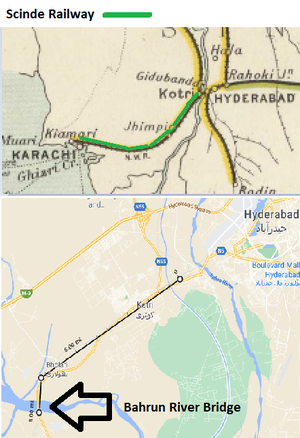| The Families In British India Society (FIBIS) is a self-help organisation devoted to members researching their British India family history and the background against which their ancestors led their lives in India under British rule. Let FIBIS help you break down those brick walls in your research |
Bahrun Valley Viaduct

The Bahrun Valley Viaduct was the longest bridge on the 'Karachi-Kotri Section' and is a viaduct across the Bahrun River. Construction on this bridge by the ‘Scinde Railway ’ was started on 5 March 1859 and completed on 26 January 1861 [1].
Kotri is on the west bank of the Indus River, facing Hyderabad on the east bank. The bridge over the Bahrun River (now called the Baran River) is 7 miles(11km) south west from Kotri
The ‘Scinde Railway ’ was amalgamated in 1870 to form the ‘Scinde, Punjaub & Delhi Railway ’ , and which in 1886 became part of the ‘North Western Railway ‘(NWR) when the line and this bridge became part of the ‘NWR Mainline’.
The Viaduct
The route involved construction a large stone viaduct, the heaviest piece of masonry upon the line with a length of 1,728 feet(527 metres), work commenced 1859 and completed in Jan 1861 [2].
Personnel
- William Arthur Brunton was responsible for the erection of the thirty-two 45 foot (13.7M) spans of the 'Bahrun Valley Viaduct' [3].
References
- ↑ "Karachi to Kotri: The First Railways in Pakistan" by Owais Mughal, 2009; Retrieved 7 Apr 2020
- ↑ All Things Pakistan “Karachi to Kotri - The first railways in Pakistan” by Owais Mughal, Posted on September 17, 2009; Retrieved on 24 Nov 2020
- ↑ Google Books "The Archaeology of an Early Railway System: The Brecon Forest Tramroads" by Stephen Hughes, page 126; Retrieved 7 Apr 2020